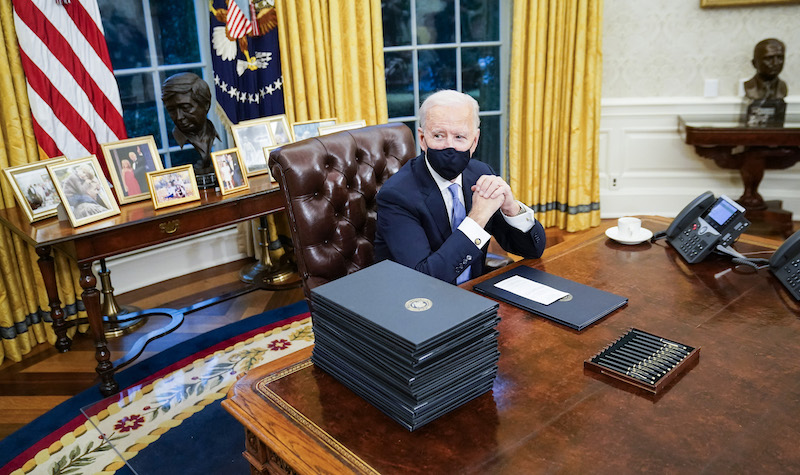
The Biden memorandum signals continuity in some areas of regulatory practice and dramatic shifts in others.
Upon taking office in January, President Joe Biden wasted no time in setting the federal government on a regulatory path very different from his predecessor. On his first evening in office, he froze regulations in the pipeline and reversed President Donald J. Trump’s regulation-related executive orders. He also issued a memorandum on “modernizing regulatory review” that signaled continuity in some regulatory practices and potentially dramatic shifts in others.
The memorandum “reaffirms the basic principles set forth” in President Bill Clinton’s 1993 Executive Order 12,866 and President Barack Obama’s 2011 Executive Order 13,563. These longstanding, bipartisan principles call for agencies to analyze the effects of alternative regulatory approaches before they issue rules, with the goal of ensuring that federal policies do more good than harm. They are key to what I have called “regulatory humility,” which appreciates that no matter how well-intentioned and intelligent regulators are, they lack essential information on how policies will work in practice.
The ex ante regulatory impact analysis that these orders require holds regulators accountable to the public by making them show their work. Agencies must demonstrate that regulatory decisions are based on a balanced understanding of competing considerations, including a holistic, evidence-based assessment of all regulatory impacts—negative as well as positive, and unintended as well as intended.
In addition to acknowledging the value of existing practices, the memorandum also directs the Office of Management and Budget (OMB) to work with agencies to develop new recommendations to improve and modernize regulatory review to “promote public health and safety, economic growth, social welfare, racial justice, environmental stewardship, human dignity, equity, and the interests of future generations.” It focuses on several areas of reform, some of which have more promise than others.
The memorandum specifically calls for revisions to OMB’s Circular A-4, the 2003 blueprint for conducting regulatory analysis. Although there likely are “developments in scientific and economic understanding” that could improve these guidelines, OMB should make modifications judiciously.
Circular A-4 has served as an authoritative source on regulatory analysis throughout the world because it is grounded in theory and empirical evidence, rather than prevailing political passions. The open process for issuing the Circular also contributes to its acceptance and to its stability across changes in administrations. When revising Circular A-4, the Biden Administration should ensure opportunities for meaningful public comment and avoid engagement only with selected “stakeholders.”
It is concerning that the focus of the recommended revisions appears unbalanced—targeted at avoiding “harmful anti-regulatory or deregulatory effects”—without attention to harmful effects of potentially excessive regulation. This revision is an understandable reaction to the last Administration’s expressed devotion to reducing regulatory costs. Despite former President Trump’s rhetoric, however, the Office of Information and Regulatory Affairs (OIRA) continued to examine each individual regulation based on its expected net benefits. This Administration’s rhetoric might also be tempered by experience.
The memorandum also seeks recommendations for “procedures that take into account the distributional consequences of regulations.” Elsewhere, I have discussed the importance of analyzing distributional impacts for setting “more compassionate, just, and equitable policies.” Although distributional impacts have long been an important element of regulatory impact analysis, regulations would benefit from a more rigorous approach to understanding the potential benefits and burdens of alternative policies on different segments of the population. This approach is particularly important for policies that affect the “disadvantaged, vulnerable, or marginalized communities” noted in the memorandum.
Here, regulatory humility calls for an objective and dispassionate examination of the incidence of both regulatory benefits and costs to understand how alternative approaches to addressing a problem affect different groups. Regulatory interventions in the economy create opportunities for rent seeking, as well-connected interest groups lobby for policies that benefit a few, while individuals bearing the costs lack the resources to push back. A sound approach to distributional analysis will be cognizant of these rent-seeking costs, and carefully and objectively evaluate both regulatory benefits and costs to avoid well-intentioned policies that can harm vulnerable populations—for example, by reducing employment or other opportunities.
I am troubled that the memorandum directs OMB and other agencies to “consider ways that OIRA can play a more proactive role” such that “regulatory review serves as a tool to affirmatively promote regulations that advance” the Administration’s priorities.
OIRA review has always played an important coordinating function across an administration. As part of the Executive Office of the President, it is well-positioned to work with policy officials to ensure agencies’ regulatory actions reflect presidential priorities. This new language, however, suggests that OIRA should take a more active role in identifying and promoting new regulatory initiatives. As a former administrator and analyst at OIRA, I find this suggestion unrealistic.
OIRA has a staff of about 45 career civil servants, a tiny fraction of the hundreds of thousands of regulatory staff at federal agencies who are highly motivated to expand their jurisdictions in new ways. Across its functions, OMB contributes to good government by serving as a check on agencies’ natural desire to want more for their particular missions—including more resources, more legislative authority, and more procurement—and OIRA is no exception. Asking OIRA, which is already stretched thin, to identify new regulatory initiatives is akin to asking the budget examiners to find new ways for agencies to spend tax dollars.
I am also not sure what the memorandum means when it asks agencies to “identify reforms that will promote the efficiency, transparency, and inclusiveness of the interagency review process.” Although transparency and inclusiveness hardly seem controversial, those principles should not invite those of us outside the government to peer into the inner workings of the interagency review process—no matter how much we would like to.
When it comes to interactions with entities outside the executive branch, OIRA’s review process is already more transparent than most other areas of government, with meetings and participants recorded and posted online for the public. But interagency review is done before agencies officially propose or finalize policies. This review is protected as a deliberative process, and appropriately so. Were it to occur in a fishbowl, staff across the government would be less willing to exchange insights, analyses, and concerns candidly—and policies would be worse for it.
But procedures to improve transparency of guidance documents will be needed. In revoking former President Trump’s regulatory executive orders, President Biden threw at least one baby out with the bathwater. He abandoned Executive Order 13,891, which required agencies to seek public input when developing significant new guidance and to make all their guidance readily accessible online. This executive order was one Trump initiative that received general support from a wide range of law and policy experts who have worried about lack of transparency and abuse of guidance for decades.
Agencies have already begun to walk back from the transparent practices they had adopted in response to the Trump order, including the posting of guidance documents in a central location. The new Administration should work quickly to ensure the progress made on making agency guidance transparent is not lost.
All told, the memorandum calls on OMB and other agencies to take some important steps to modernize regulatory review, but it also exudes a confidence in the federal government’s ability to act swiftly to address a series of challenges without recognizing the potential unintended consequences of acting too quickly or aggressively.
It foreshadows a move away from the bipartisan emphasis on evidence-based policy and from regulatory humility, which “requires a disciplined approach to understanding regulatory impacts and tradeoffs; maintaining practices that encourage accountability; a commitment to learning, feedback, and evaluation; an openness to diverse views and inputs;” as well as “reliance on flexible regulatory tools.”
President Biden certainly displays more personal humility than his predecessor. If his ambitious regulatory agenda is to be successful, he must embrace regulatory humility as well.
This essay is part of a six-part series entitled Regulatory Review Reimagined.




